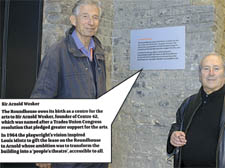|
|
 |
| |
 Sir Arnold Wesker at the Roundhouse: 'I feel like I'm travelling back in time' Sir Arnold Wesker at the Roundhouse: 'I feel like I'm travelling back in time' |
Playwright Wesker’s sentimental journey to Roundhouse
PLAYWRIGHT Sir Arnold Wesker returned to Chalk Farm Roundhouse on Tuesday for a guided tour of the arts and music venue 40 years after he helped turn the former train shed and gin warehouse into a performance space.
Sir Arnold, who was knighted this year, unveiled a plaque to commemorate the work he and his arts group, Centre 42, did to turn the empty 1848 building into a theatre and gallery.
Joined by toy magnate Torquil Norman, who has spent 10 years raising £30 million to renovate the Roundhouse, he said: “When I first came here in the 1960s I thought: this is just not what I am looking for.
“I slept on it and then changed my mind, and then set about raising funds to get it open.”
The history of Centre 42 begins in 1960 with his criticism of the Labour movement for neglecting the role the arts play in society. The following year it prompted the Trade Union Congress to pass article 42 on its agenda – vowing to look into arts provision.
Sir Arnold then staged an arts festival, sponsored by trades councils, and finally looked for a full-time base for his work.
Journalist Alan Brien first told Sir Arnold about the Roundhouse. Clothing magnate and property dealer Louis Mintz had bought the building without any idea what he would use it for – until Sir Arnold met him.
Sir Arnold recalled: “I went to Louis and asked if he would give us the 19-year lease. Later he said: ‘If anyone had told me I would give you it, I would have thought them mad.’
“But one way of persuading people of the viability of a project is to behave as though it already exists. So we designed the 42 Appeal. I ordered only 16 copies for Louis to show his directors but it was enough to persuade him.”
By getting some of the biggest names in British theatre to back the plans, Louis Mintz was brought on side.
Sir Arnold continued: “We had all these impressive names – Lord Harewood, Peggy Ashcroft, Professor Ayer, Sir Arthur Bliss, Benjamin Britten, Albert Finney, Menuhin, Olivier, Terence Rattigan. I was appealing to everyone for help, from Harold Wilson to Prince Philip.”
Harold Wilson paid for an administrator, George Hoskins, to help manage the project and money was raised to commission architect René Allio. Over the years £650,000 was raised for the project, but, due to financial constraints, Centre 42 was never finished to the degree Sir Arnold had envisaged.
And the first performance he put on was not one he cares to remember.
“It was not very good,” he recalled. “The play itself was fine, but I had a feeling the leading actor was determined to sabotage it, so I told the stage manager he had better learn his part and take over. In the end the leading man was no good and it was a shame.”
Today’s Roundhouse still owes a debt to Sir Arnold.
Roundhouse Trust chairman Torquil Norman said: “Arnold Wesker has been a fine example. His plans had lots in common with ours.
“It is a pleasure to honour him as the person who first saw the potential in the Roundhouse and worked so hard to realise it.
“The wonderful artists who performed there in the 60s and 70s, by making the Roundhouse so famous, have made our job much easier.”
Sir Arnold added: “I feel the ghosts of Centre 42 running through me, and I feel like I am travelling back in time. Today has been a very nostalgic, sentimental journey.”
And he would not rule out a return of one of his most famous plays, The Kitchen, to the centre.
He added: “I’d like to do the musical version here again. It is a fabulous venue.”
|
 |
|
 |
|